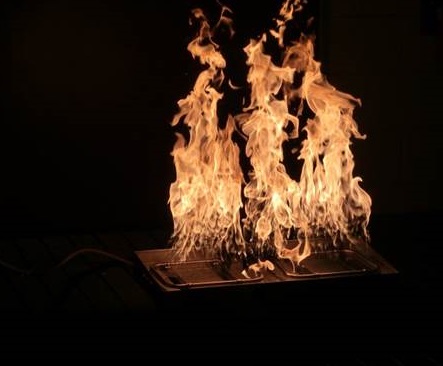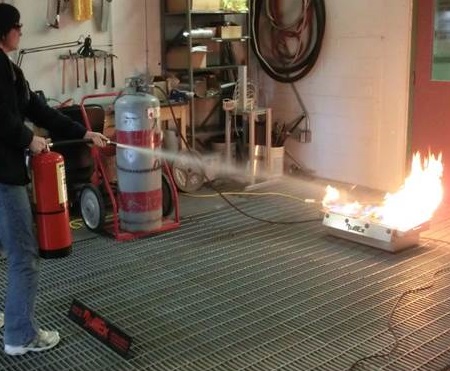By William D. Hicks
Portable fire extinguishers serve as an important line of defense and life safety device helping to protect people and property from fire in all built environments including workplace settings, areas occupied by the general public, vehicles, marine areas, and aviation. In a variety of environments, portable fire extinguishers are required by fire, life safety, and occupational safety codes to be installed, maintained, serviced regularly, and kept accessible for immediate use of occupants in the area. Such requirements are found in the National Fire Protection Association 10, Inspection, Testing and Maintenance of Portable Fire Extinguishers. This standard is incorporated by reference in many model codes and federal regulations.
Although many of the codes require that fire extinguisher training be provided to employees, a large portion of those exposed to areas with fire extinguishers are untrained individuals, referred to as “novices.”
“Civilians cannot safely use fire extinguishers” is a common refrain from some in the fire services. Others believe that civilians using fire extinguishers are more likely to injure themselves, put others at risk, or escalate the situation. This assumption influences how fire codes are written and ultimately impacts the availability of fire extinguishers in public buildings. The reality is that until recently, there was not any research to support or refute this argument. To test these theories, researchers from the Department of Fire Protection Engineering at Worcester Polytechnic Institute (WPI) and the Fire Protection and Safety Engineering Technology Program at Eastern Kentucky University studied whether or not ordinary people with no previous training (novice users) can safely use portable fire extinguishers effectively. The results of the study clearly demonstrated that most novices handle fire extinguishers correctly and are able to pull the pin and discharge the agent. Equally important, 75 percent of novices were able to safely extinguish a simulated fire with an extinguisher prop on Class AII setting. Additionally, the study found that with only minimal training, 98 percent of volunteers were able to safely extinguish a fire.

(1) A simulated fire prop provided a challenging fire for test subjects. (Photos by author.)
Kathy Notarianni, PhD Professor and Chair of WPI’s Department of Fire Protection Engineering proposed the study when she learned that many portable extinguishers were to be removed from WPI’s campus because of concerns related to civilian use (novices) of extinguishers. As a strong supporter of both passive and active fire protection, Notarianni searched for data to either confirm or disprove claims. When no conclusive data emerged, despite her exhaustive efforts, Notarianni decided to initiate her own study. She invited students from WPI as well as me and EKU Fire Protection and Safety Engineering Technology Program Lecturer Corey Hanks in to partner on the project.
The researchers wanted to answer a simple question: If a fire broke out at home or work, could a novice safely and effectively use a fire extinguisher? Because many believe that significant and costly training is necessary, researchers also wanted to determine how much training would be required to improve a novice’s use of an extinguisher.
Approximately 275 volunteers of various ages and backgrounds including students, faculty, and staff were selected at both universities. The volunteers participated in two trials. In the first exercise, volunteers were asked to use an extinguisher—without instruction or guidance except basic safety items—to extinguish a simulated fire using a training system which uses ultrasonic sensors to detect water spray and propane flames based on acoustical sensors. The system runs off of a 20-pound propane tank and can simulate class A-, B-, and C-type fires. Each participant was also given a choice of two sizes of extinguisher from which to choose.
Volunteers were rated on the following:
- Ability to use the extinguisher including what percentage could effectively extinguish the fire, what was the average time to begin discharging the extinguisher, and what percentage would read the label.
- Effectiveness of their technique such as did they aim at the base of the fire? Did they use a back-and-forth sweeping motion? Did they continue spraying after the fire appeared to be extinguished?
- Safety. Did they safely use the extinguishers? Did they stand a safe distance from the fire (at least eight feet away)? Did they turn their backs on the fire?
- Extinguishment. What percentage of volunteers was able to simulate extinguishment and what was the average time from start to extinguishment?
The study found that nearly all of the volunteers (98 percent) were able to successfully discharge the agent with an average predischarge time of 13.4 seconds. Almost three-quarters (72 percent) aimed at the base of the fire, and 74 percent used the appropriate sweeping motion. About half (48 percent) of participants continued to spray agent after the fire was no longer visible. Ultimately, 76 percent of novices were able to extinguish the fire without any training.

(2) A test subject focuses the extinguisher discharge on the base of the flame.
During the second trial, we assessed the ability of each volunteer to use an extinguisher with a small amount of training from the researchers. This simple training program required researchers to read a brief outline describing proper extinguisher usage to the volunteer. Once the volunteers received this basic training session, the results increased dramatically. The volunteers who aimed at the base of the fire increased to 93 percent, those who used a sweeping motion increased to 96 percent, and those who continued to spray after the fire was no longer visible improved to 83 percent. These improvements led to 98 percent of volunteers displaying the skills required to extinguish the fire.
The purpose of fire extinguishers is twofold. First and foremost, they are used as a method for protection of life in case someone becomes cut off from the path of egress. Second, they are used for the extinguishment of incipient stage fires once occupants have evacuated and the fire department is notified. The basic tenants of the need for immediate evacuation of all occupants coupled with immediate notification of fire and emergency services should not change. This research was not intended to imply any change to such an approach. The primary response to a fire emergency is for the occupants leave the building. Only after all other life safety concerns are addressed and the fire is still in an incipient stage should you consider using a fire extinguisher.
Prior to this study, no information existed that demonstrated whether novice users could use a fire extinguisher effectively. Protection planners now have substantiation that novice users are able to deploy fire extinguishers effectively and that, with minor training, can increase success in using fire extinguishers.
The implications of this study are apparent; it clearly demonstrates that novices can safely use extinguishers as a first line of defense. The findings of this study have been presented at NFPA, the annual meeting of the National Association of State Fire Marshals, and several other fire protection organizations.
Several limitations exist. The stress of a real event certainly might play a role in the success of some users. This study calls for additional research in the area of fight-or–flight reaction and its impact on the ability of novices to use portable extinguishers. Another need identified is for testing to include different types of fires.
Find the study at http://www.femalifesafety.org/docs/WPIStudyFinal.pdf.
Author’s note: I would like to thank the WPI research team of Kathy Ann Notarianni, professor and head of department; Randy Harris, lab coordinator; and Brandon Poole, undergraduate student and the EKU research team of Faculty of Physical Sciences and Engineering Program Coordinator Gregory E. Gorbett and Lecturer/Lab Manager Corey Hanks.
William D. Hicks is an assistant professor for the Department of Safety, Security and Emergency Management at Eastern Kentucky University. He has a BS in Fire & Safety Engineering Technology and a MS in Loss Prevention and Safety from Eastern Kentucky University. He is the assistant chief of the Whitehall (KY) Fire Department. He is a NAFI- and IAAI-certified fire, arson, and explosive investigator and a National Fire Protection Association-certified fire protection specialist.

